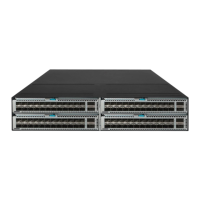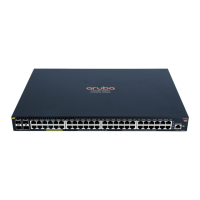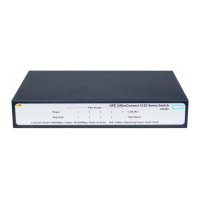3
Ethernet OAM link events Description
Errored frame period event
An errored frame period event occurs when the number of frame errors in
the detection window (specified number of received frames) exceeds the
predefined threshold.
Errored frame seconds event
An errored frame seconds event occurs when the number of errored
frame seconds (the second in which an errored frame appears is called an
errored frame second) detected on a port in the detection window
(specified detection interval) reaches the predefined threshold.
Remote fault detection
Information OAMPDUs are exchanged periodically among Ethernet OAM entities across established
OAM connections. In a network where traffic is interrupted due to device failures or unavailability, the
flag field defined in Information OAMPDUs allows an Ethernet OAM entity to send error information
(any critical link event type shown in Table 4) to its
peer. You can use the log information to track
ongoing link status and troubleshoot problems promptly.
Table 4 Critical link events
Type Description
OAMPDU transmission
frequencies
Link Fault Peer link signal is lost. Once per second.
Dying Gasp
An unexpected fault, such as power failure,
occurred.
Non-stop.
Critical Event An undetermined critical event happened. Non-stop.
The switch is able to receive Information OAMPDUs carrying the critical link events listed in Table 4.
The switch is able to send Information OAMPDUs carrying Link Fault events.
The switch is able to send Information OAMPDUs carrying Dying Gasp events when the switch is
rebooted or relevant ports are manually shut down. Physical IRF ports, however, are unable to send
this type of OAMPDUs.
The switch is unable to send Information OAMPDUs carrying Critical Events.
Remote loopback
Remote loopback is available only after the Ethernet OAM connection is established. With remote
loopback enabled, the Ethernet OAM entity in active mode sends non-OAMPDUs to its peer. After
receiving these frames, the peer does not forward them according to their destination addresses.
Instead, it returns them to the sender along the original path.
Remote loopback enables you to check the link status and locate link failures. Performing remote
loopback periodically helps to detect network faults promptly. Furthermore, performing remote
loopback by network segments helps to locate network faults.
Protocols and standards
IEEE 802.3ah, Carrier Sense Multiple Access with Collision Detection (CSMA/CD) Access Method
and Physical Layer Specifications
Ethernet OAM configuration task list
Tasks at a glance
(Required.) Configuring basic Ethernet OAM functions

